HESI VI EXIT EXAM QUESTIONS AND CORRECT ANSWERS (100%)
Document Content and Description Below
HESI V1 2018 EXIT EXAM QUESTIONS 2. A client who is admitted to the care unit with syndrome of inappropriate antidiuretic hormone (SIADH) has developed osmotic demyelination. Which interventi... on should the nurse implement first? A) Patch one eye. B) Evaluate swallow. C) Reorient often. D) Range of motion. 3. The nurse is preparing a client who had a below-the-knee (BKA) amputation for discharge to home. Which recommendations should the nurse provide this client? (Select all that apply) A) Wash the stump with soap and water. B) Avoid range of motion exercise. C) Apply alcohol to the stump after bathing. D) Inspect skin for redness. E) Use a residual limb shrinker. 4. After 2 days treatment for dehydration, a child continues to vomit and have diarrhea. Normal saline is infusing and the child’s urine output is 50ml/hour. During morning assessment, the nurse determines that the child is lethargic and difficult to arouse. Which should the nurse implemented? A) Increase the IV fluid flow rate. B) Review 24 hour intake and output. C) Obtain arterial blood gases. D) Perform a finger stick glucose test. 6. A male client with an antisocial personality disorder is admitted to an in patient mental health unit for multiple substance dependency. When providing a history, the client justifies to the nurse his use of illicit drugs. Based on this pattern of behavior, this client’s history is most likely to include which finding? A) Multiple convictions for misdemeanors and Class B felonies B) Delusions of grandiosity and persecution. C) Suicidal ideations and multiple attempts. D) Photos and panic attacks when confronted by authority figures. 7. An older client is admitted for repair of a broken hip. To reduce the risk for infection postoperative period., which nursing care intervention should the nurse include the client’s plan of care? (Select all that apply) A) Administer low molecular weight heparin as prescribed. B) Teach client to use incentive spirometer every 2 hours while awake. C) Remove urinary catheter as soon as possible and encourage voiding. D) Maintain sequential compression devices while in bed. E) Assess pain level and medicate PRN as prescribed. 9. A client with arthritis has been receiving treatment with naproxen and now reports ongoing stomach pain, increasing weakness, and fatigue. Which laboratory test should the nurse monitor? A) Serum Calcium. B) Erythrocyte sedimentation rate. C) Osmolality. D) Hemoglobin. 10. A client with bacterial meningitis is receiving phenytoin. Which assessment finding indication to the nurse that the client is experiencing a therapeutic response to the phenytoin? A) Increased time of ambulation between periods of rest. B) Decrease in intracranial pressure and cerebral edema. C) Absence of seizure activity for the duration of treatment. D) Normal electroencephalogram after drug administration. 11. A client peptic ulcer disease receives a prescription for intermittent suction via a SalemSump nasogastric tube (NGT). After inserting the NGT and obtaining coffee- ground gastric contents, the nurse clamps the NGT because the client must leave the unit for diagnostic studies. Upon return to the unit, the client complains of nausea. What action should the nurse implement first? A) Administering a prescribed antiemetic agent. B) Provide oral suction using a Yankauer tip. C) Connect the NGT to low intermittent suction. D) Irrigate the NGT with sterile normal saline. 12. The healthcare provider prescribes a fluid challenge of 0.9% sodium chloride 1,000 ml to be influenced over 4 hours. The IV administration set delivers 10 gtt/ml. How many gtt/minute should the nurse regulate the infusion? ( round the nearest whole number.) 13. A family member reports that the client who is bedridden has not been turned or repositioned all night and is sleeping on a special air mattress with no sheets. What information should the nurse provide to the family member? A) Clarify that an aerated support surface does not use sheets that often cause skin breakdown. B) Described the night staff’s plan of care to ensure the client’s sleep is not disturbed. C) Explained that turning is only necessary to reposition the client during waking hours. D) Suggest that a family member turn the client during the night when someone is there. 15. A client with bleeding esophageal varies receives vasopressin IV. What should the nurse monitor for during the IV infusion of this medication? A) Vasodilation of the extremities. B) Chest pain and dysrhythmia. C) Hypotension and tachycardia. D) Decreasing GI cramping and nausea. 16. The healthcare provider prescribes potassium chloride 25 mEq in 500ml D5W to infuse over 6 hours. The available 20ml vial of potassium chloride is labeled, “How many ml of potassium chloride should the nurse add to the IV fluid? (Round to the nearest tenth.) 17. A male client reports to the on-call clinic nurse that he took tadalif 10 mg PO two hours age and his skin now feels flushed. He reports a history of stable angina, but denies experiencing any current or recent chest pain. What action should the nurse take? A) Tell the client to have someone bring him to an emergency department immediately. B) Advise the client to place one nitroglycerin tablet under his tongue as a precaution. C) Reassure the client that skin flushing is a common side effect of the medication. D) Instruct the client to increase his intake of oral until the skin flushing is relieved. 18. The nurse is performing a peritoneal dialysis exchange on a client with chronic kidney disease (CKD). Which assessment finding should the nurse report to the healthcare provider? A) The client complains of abdominal fullness and cramping during installation. B) The client complains of a slight shortness of breath during installation. C) The amount of the returning dialysis fluid is greater than the amount instilled. D) The appearance of the returning dialysate fluid is cloudy. 19. The healthcare provider prescribed furosemide for a 4-year old child who has a ventricular septal defect. Which outcome indicates to the nurse that this pharmacological intervention was effective? A) Urine specific gravity change from 1.021 to 1.031 B) Daily weight decrease of 2 pounds (0.9 kg) C) Urinary output decrease of 5 ml/hour. D) Blood urea nitrogen (BUN) increase from 8 to 12 mg/dl (2.9 to 4.3) 20. The nurse is preparing to administer an oral antibiotic to a client with unilateral weakness, ptosis, mouth drooping, and aspiration pneumonia. What is the priority nursing assessment that should be done before administering this medication? A) Ask the client about soft food preferences. B) Determine which side of the body is weak. C) Obtain and record the client’s vital signs. D) Auscultate the client’s breath sounds. 21. The nurse is demonstrating correct transfer procedures to the unlicensed assistance personnel (UAP) working on a rehabilitation unit. The UAP asks the nurse how to safely move a physically disabled client from the wheelchair to a bed. What action the nurse recommend? A) Apply a gait belt around the client’s waist once a standing position has been assumed. B) Pull the client into position by reaching from the opposite side of the bed. C) Hold the client at arm’s length while transferring to better distribute the body weight. D) Place the client’s locked wheelchair on the client’s strong side next the bed. 22. A young adult woman visits the clinic and learns that she is positive for BRCA1 gene mutation and asks the nurse what to expect next. How should the nurse respond? A) Provide information about survival rates women who have this genetic mutation. B) Gather additional information about the client’s family history for all types of cancer. C) Offer assurance that there are a variety of effective treatments for breast cancer. D) Explain that counseling will be provided to give her information about her cancer risk. 23. The nurse is supervising an unlicensed assistive personnel (UAP) who will be providing personal care for a client with watery diarrhea caused by Clostridium difficile. Which action by the nurse takes priority? A) Remind the UAP to keep the client’s water pitcher filled. B) Review use of personal protective equipment with the UAP. C) Provide barrier cream for application to the perineal area. D) Instruct the UAP to record the number of bowel movements. 24. The nurse enters the room of a client who is awaiting surgery for appendicitis. The unlicensed assistive personnel (UAP) has helped the client to a position of comfort with the right leg flexed and has applied a heating pad to the client’s abdomen to relieve the client’s pain. Which action should the nurse implement first? A) Determine if the consent form has been signed by the client. B) Remove the heating pad from the client’s abdominal area. C) Confirm that the UAP has assisted the client to a position of comfort. D) Evaluate the effectiveness of the heating pad in relieving pain. 25. The nurse completed a dressing change for a client with partial thickness burns to both legs. After completing the dressing change, What intervention should the nurse implement? A) Administer a PRN dose of pain medication. B) Raise this head of bed to a 90 angle. C) Perform passive range of motion. D) Position ankles in a dorsiflexed position. 26. A client is admitted to a medical unit with a diagnosis of gastritis and chronic heavy alcohol abuse. What should the nurse administer to prevent the development of Wernicke’s syndrome? A) Atenolol. B) Famotidine. C) Thiamine. D) Lorazepam. 27. Following laser trabeculoplasty surgery for open-angle glaucoma, the client reports acute pain deep within the eye. What action should the nurse take? A) Apply bilateral eye shields to reduce photosensitivity. B) Begin postoperative prophylactic antibiotics. C) Administer an antiemetic to prevent vomiting. D) Report the complain of eye pain to the surgeon. 28. A male client with cirrhosis has jaundice and pruritis. He tells the nurse that he was been soaking in hot baths at night with no relief of his discomfort. What action should the nurse take? A) Explain that the symptoms are caused by liver damage and cannot be relieved. B) Encourage the client to use cooler water and apply calamine lotion after soaking. C) Obtain a PRN prescription for an analgesic that the client can use for symptom relief. D) Suggest that the client take brief showers and apply oil-based lotion after showering. 30. A 17-year-old adolescent is brought to the Emergency Department by both parents because the adolescent has been coughing and running a fever with flu-like symptoms for the past 24 hours. Which intervention should the nurse implement first? A) Assess the client’s temperature. B) Place a mask on the client’s face. C) Determine the client’s blood pressure. D) Obtain a chest x-ray per protocol. 31. The nurse is preparing to administer an IV dose of ciprofloxacin to a client with a urinary tract infection. Which client data requires the most immediate intervention by the nurse? A) White blood cell count of 12,000 mm^3 (12 x 10^9/L SI) B) Serum sodium of 145 men/L (145 mm/L SI) C) Urine culture positive for MRSA. D) Serum creatinine of 4.5mg/dl (398 mom/L SI) 32. A young adult female presents at the emergency center with acute lower abdominal pain. Which assessment finding is most important for the nurse to report to the healthcare provider? A) Reports white, curly vaginal discharge. B) Last menstrual period 7 weeks ago. C) History of irritable bowel syndrome (IBS) D) Pain scale rating of a “9” on a 0-10 scale. 33. A client is admitted to the intensive care unit with diabetes insidious due to a pituitary gland tumor. Which potential complication should the nurse monitor closely? A) Ketonuria. B) Peripheral edema. C) Hypokalemia. D) Elevated blood pressure. 34. A male client is returned to the surgical unit following a left nephrectomy and is medicated with morphine sulfate 4 mg IV. His dressing has a small amount of bloody drainage, and a Jackson-Pratt bulb surgical drainage device is in place. Which intervention is most important for the nurse to include in this client’s plan of care? A) Assess for back muscle aches. B) Obtain body weight daily. C) Monitor urinary output hourly. D) Record drainage from drain. 36. When administering ceftriaxone sodium intravenously to a client before surgery, which assessment finding requires the most immediate intervention b the nurse. A) Headache. B) Pruritis. C) Stridor. D) Nausea. 37. The nurse is complaining an admission assessment for a male client with paranoid schizophrenia. The client tells the nurse that the staff dislikes him. What action should the nurse take? A) Assess the client’s speech pattern for a flight of class. B) Observe the client for obsessive activities such as repeated hand washing. C) Determine if the client has formulated any plans regarding the staff. D) Ask the client if he has a plan to harm himself. 39. The nurse is teaching a mother of a newborn with a cleft lip how to bottle feed her baby using a Medela Haberman feeder, which has a valve to control the release of milk and a slit nipple opening. The nurse discusses placing the nipple’s elongated tip in the back of the oral cavity. What instruction should the nurse provide the mother about feedings? A) Alternate milk with water during the feedings. B) Squeeze the nipple base to introduce milk into the mouth. C) Position the baby in the left lateral position after feeding. D) Hold the newborn in an upright position. 40. When caring for a client with a traumatic brain injury (TBI) who had a craniotomy for increased intracranial pressure (ICP), the nurse assesses the client using the Glasgow coma scale (GCS) every two hours. For the past 8 hours the client’s GCS score has been 14. What goes this GCS finding indicate about this client? A) Rehabilitative prognosis is an expected full recovery. B) Insertion of an ICP monitoring device is necessary. C) Neurologically stable without indications of an increased ICP. D) Risk for irreversible cerebral damage related to increased ICP. 41. While caring for a client’s postoperative dressing the nurse observes purulent wound drainage. Previously, the wound was inflamed and tender but without daring. Which is the most important action for the nurse to take? A) Determines if the drainage has an unpleasant B) Cleanse the wound with a sterile saline solution. C) Request a culture and sensitivity of the wound. D) Monitor the client’s white blood cell count (WBC). 42. Following morning care, a client with a C-% spinal cord injury who is sitting in a wheelchair becomes flushed and complains of a headache. Which interventions should the nurse implement first? A) Assess the client’s blood pressure every 15 minutes. B) Relieve any kinks or obstruction in the client’s Foley tubing. C) Teach the client to response symptoms of dyreflexia. D) Administer a prescribed PRN dose of hydrazine (Apresoline.) 43. The nurse is planning care for a young adult client with acromegaly. It is most important for the nurse to monitor which of the client’s serum laboratory test results? A) White blood cell count. B) Glucose. C) Hemoglobin. D) Partial thromboplastin time. 44. A client with history of adrenal insufficiency is admitted to the intensive care unit with an acute adrenal crisis. The client is complaining of nausea and joint pain.Vital signs are: temperature 102 F (38.9 C) heart rate 138 beats/minute, blood pressure 80/60 mmHg. Which intervention should the nurse implement first? A) Administer PRN oral antipyretic. B) Infuse an intravenous fluid bolus. C) Obtain an analgesic prescription. D) Cover client with cooling blanket. 45. The nurse supplies a blood pressure cuff around a client’s left thigh. To measure client’s pressure, where should the diaphragm of the stethoscope be placed? (Mark location on image) 46. The nurse is evaluating the diet teaching of a client with hypertension. What dinner selection indicates that the client understands the dietary recommendations for hypertension? A) Grilled steak, baked potato with sour cream, green beans, coffee. B) Beef stir fry, fried rice, egg drop soup, Diet Coke, and pumpkin pie. C) Tomato soup, grilled cheese sandwich, pickles, skim milk, and lemon menage pie. D) Baked pork chop, applesauce, corn on the cob, 1% milk, and key lime pie. 47. A child newly diagnosed with sickle cell anemia (SCA) is being discharged from the hospital. Which information is most important for the nurse to provide the parents prior to discharge? A) Referral for social services for the child and family. B) Instruction about how much fluid the child should drink daily. C) Signs of addiction to opioid pain medications. D) Information about non-pharmaceutical pain relief measures. 50. A client who had a percutaneous coronary intervention (PCI) two weeks ago returns to the clinic for a follow up visit. The client has a postoperative ejection fraction of 30%. Today the client has links which are clear, +1 pedal edema, and a 5 pound weight gain. Which intervention should the nurse implement? A) Insert saline lock for IV diuretic therapy. B) Arrange transport for admission to the hospital. C) Assess compliance with routine prescriptions. D) Instruct the client to monitor daily caloric intake. 53. Following a gunshot wound, an adult client has a hemoglobin level 4 grams/dl (40 mmil/L SI). The nurse prepares to administer a unit of blood for an emergency transfusion. The client has AB negative blood type and the blood bank sends a unit of Type A Rh negative, reporting that there is no Type AB negative blood currently available. Which intervention should the nurse implement? A) Administer normal saline solution until Type AB negative is available. B) Obtain additional consent for administration of Type A negative blood. C) Transfuse Types A negative blood until Type AB negative is available. D) Recheck the client’s hemoglobin, blood type, and Rh factor. 55. An S3 heart sound is auscultated in a client in her third trimester of pregnancy. What intervention should the nurse take? A) Prepare the client for an echocardiogram. B) Limit the client’s fluids. C) Document in the client’s record. D) Notify the healthcare provider. 57. Prior to obtaining a trapeze bar for a client with limited mobility, which client assessment is most important for the nurse to obtain? A) Balance and posture. B) Pressure sore risk. C) Risk for disuse syndrome. D) Upper body muscle strength. 59. A mother runs into the emergency department with a toddler in her arms and tells the nurse that her child got into some cleaning products. The child smells of chemicals on hands, face and on the front of the child’s clothes. After ensuring the airway is patent, what action should the nurse implement first? A) Obtain equipment for gastric lavage. B) Determine type of chemical exposure. C) Assess child for altered sensorium. D) Call poison control emergency number. 60. The nurse enters room of a client with Parkinson’s disease who is taking carbidopa levodopa. The client is arising slowly from the chair while the unlicensed assistive personnel (UAP) stands next to the chair. What action should the nurse take? A) Demonstrate how to help the client move more efficiently. B) Affirm that the client should arise slowly from the chair. C) Tell the UAP to assist the client in moving more quickly. D) Offer a PRN analgesic to reduce painful movement. 62. A middle aged female client tells the clinic nurse that she has lost an inch of height in the last year. What is the priority nursing intervention? A) Assist the client to schedule a bone density exam. B) Observe for the presence of a dowager’s C) Advice the client to begin stretching exercises. D) Encourage the client to eat calcium rich foods. 63. An adult female tells the nurse that her grandmother was diagnosed with colorectal cancer at age 75 and the client is implementing measures to reduce her own risk. Which of the client’s plans indicates the need for additional information? A) Annual sigmoidoscopy screening. B) Increased intake of fresh fruits, vegetables, and whole grains. C) Reduced dietary intake of animal fat and protein. D) Yearly fecal occult blood testing. 64. In early septic shock states, what is the primary cause of hypotension? A) Peripheral vasodilation. B) Cardiac failure. C) A vagal response. D) Peripheral vasoconstriction. 65. Four clients arrive on the labor and delivery unit at the same time. Which client should the nurse assess first? A) A 3-week multigravida with a prescription for serial blood pressures. B) A 39-week primigravida with biophysical profile score of 5 out of 8. C) A 38- week primigravida who reports contractions occurring every 10 minutes. D) A 41-week multigravida who is scheduled induction of labor today. 65. A male client with cirrhosis has jaundice and pruritis. He tells the nurse that he has been soak in hot baths at night with no relief of his discomfort. What action should the nurse take? A) Suggest that the client take brief showers and apply oil-based lotion after showering. B) Explain that the symptoms are caused by liver damaged and cannot be relieved. C) Encourage the client to use cooler water and apply calamine lotion after soaking. D) Obtain a PRN prescription for an analgesic that the client can use for symptom relief. 67. An adult client experiences a gasoline tank fire when riding a motorcycle and is admitted to the emergency department (ED) with full thickness burns to all surfaces of both lower extremities. What percentage of body surface area should the nurse document in the electronic medical record (EMR)? A) 36% B) 9% C) 45% D) 15% 68. While teaching a young male adult to use an inhaler for his newly diagnosed asthma, the client stares into the distance and appears to be concentrating on something other than the lesson the nurse is presenting. What action should the nurse take? A) Remind the client that a rescue inhaler might save his life. B) Gently touch the client then continue with the teaching. C) Ask the client what he is thinking about at this time. D) Leave the client alone so that he can grieve his illness. 70. A male client is admitted to the hospital due to multiple fractures following a motor vehicle collision that occurred when he ran his car into his ex-spouse’s home. When the client becomes angry and starts throwing objects at the staff, which PRN prescription should the nurse implement? A) Apply soft wrist restraints if needed for client safety. B) Consult with the chaplain emotional support. C) Hydromorphone (Dilaudid) 2mg IV. D) Haloperidol (Haldol) 1mg IM. 71. When caring for a client who has acute respiratory distress syndrome (ARDS), the nurse elevates the head of the bed 30 degrees. What in the reason for this intervention ? A) To promote retraction of the intercostal accessory muscles. B) To reduce abdominal pressure on the diaphragm. C) To decrease pressure on the medullary center which stimulates breathing. D) To promote bronchodilation and effective airway clearance. 72. As adult client’s apicalpulss is 110 beats per minute. What intervention should the nurse implement first? A) Assess the client’s radial pulse and apical pulse at the same time. B) Assess the client to determine the reason why the pulse is elevated. C) Notify the charge nurse that the client’s pulse is elevated. D) Attempt to calm the client and take the pulse again in one hour. 74. The nurse is planning discharge teaching for a client who had an evacuation of gestational trophoblastic disease (GTD) two days age. Which information is most important for the nurse to include in this client’s teaching plan? A) Location and times for a local support group. B) Rho(D) immune globulin to prevent isoiminuization. C) Schedule follow up visit with the healthcare provider. D) Oral contraceptive use for at least one year. 77. An infant is receiving penicillin G procaine 220,000 units IM. The drug is supplied as 600,000 units/ml. How many ml should the nurse adminster? (If rounding required, round to the nearest tenth.) 83. A client with multiple sclerosis is receiving baclofen 15mg PO three times daily. The drug is available in 10 mg tablets. How many tablets should the nurse administer in a 24 hour period? (Round to nearest tenth.) 84. An adult client with a broken femur is transferred to the medical surgical unit to await surgical internal fixation after the application of an external traction device to stabilizer the leg. An hour after an opioid analgesic was administered, the client reports muscle spasm and pain at the fracture site. While waiting for the client to be transported to surgery, which action the nurse implement? A) Reduce the weight on the traction device. B) Administer PRN dose of a muscle relaxant. C) Observe for signs of deep vein thrombosis. D) Check client’s most recent electrolyte values. 85. A heparin infusion is prescribed for a client who weighs 220 pounds. After administering a bolus dose of 80 units/kg, the nurse calculates the infusions rate for the heparin solution at 18 units?kg/hour. The available solution is Heparin Sodium 25,000 Units in 5% Dextrose Injection 250ml. The nurse should program the infusion pump to deliver how many ml/hour? 86. While assisting a client who recently had a hip replacement onto the bed pan, the nurse notices that there is a small amount of bloody drainage on the on the surgical dressing, the client’s skin is warm to touch, and there is a strong odor from the urine. Which action should the nurse take? A) Remove dressing and assess surgical. B) Measure the client’s oral temperature. C) Insert an indwelling urinary catheter. D) Obtain a urine sample from the bed pan. 88. What information should the nurse include in the discharge teaching plan of a client with low back pain who is taking cyclobenzaprine to control muscle spasms? A) Avoid using heat or ice to injured muscles while taking this medication. B) Use cold and allergy medications only as directed by a healthcare provider. C) Take the medication on an empty stomach. D) Discontinue all non steroidal anti-intiflammatory medications. 89. An older adult male is admitted with complication related to Chronic Obstructive Pulmonary Disease (COPD). He reports progressive dyspnea that worens on exertion and his weakness has increased over the past month. The nurse notes that he has dependent edema in both lower legs. Based on these assessment findings, which dietary instruction should the nurse provide? A) Limit the intake of high calorie foods. B) Maintain a low protein diets. C) Eat meals at the same time daily. D) Restricts daily fluid intake. 90. A 6- year-old child who had surgery yesterday absolutely refuses to use the incentive spirometer. Which intervention should the nurse implement? A) Ask the mother to assist when it is time to use the spirometer. B) Allow child to choose when to perform incentive spirometry. C) Contract with the child to use spirometer only after meals. D) Blow out lights, blow bubbles, and encourage child’s laughing. 92. A 15-year-old male client was recently diagnosed with type 1 diabetes mellitus. He tells the nurse that he is having difficulty adhering to his meal plan when he is with his friends. What nursing intervention is best for the nurse to implement? A) Recommend he avoid fast food restaurants until he is familiar with his prescribed diet. B) Advise him to take his own food with him when going to fast food restaurants with his friends. C) Encourage him to find activities to do with his friends that do not involve eating. D) Assist him in identifying popular fast foods that are within his meal plan for diabetes. 95. The nurse observes a practical nurse (PN) pouring warm water over the perineal area of a female client who his frequent urinary incontinence while the client is positioned on a bedpan. What action the nurse take? A) Recommend a complete bath to cleanse the perineal area more fully. B) Instruct the PN that this technique promotes infection in elderly females. C) Evaluate the effectiveness of this measure to stimulate client voiding. D) Suggest contacting the healthcare provider for a prescription for Cather insertion. 105. A client with a traumatic brain injury becomes progressively less responsive to stimuli. The client has a “Do Not Resuscitate” prescription, and the nurse observes that the unlicensed assistive personnel (UAP) has stopped turning the client from side to side as previously scheduled. What action should the nurse take? A) Encourage the UAP to provide comfort care measures only. B) Assume total care of the client to monitor neuralgic function. C) Advise the UAP to resume positioning the client on schedule. D) Assign a practical nurse to assist the UAP in turning the client. 111. When attempting to establish risk reduction strategies in a community, the nurse note that regional studies indicates a high number of persons with growth stunting and irreversible mental deficiencies caused by hypothyroidism (cretinism). The nurse should seek funding to implement which screening measure? A) TSH levels in women over 45. B) T3 levels in school-aged children. C) T4 levels in newborn. D) Iodine levels in all persons over 60. 112. An infant is unresponsive and gasping for breath. Prior to start CPR, which site should the nurse palpate for a pulse? (Image) 114. The nurse is preparing to send a client to the cardiac catheterization lab for an angioplasty. Which client report is most important for the to explore further prior to the start of the procedure? A) Drank a glass of water in the past 2 hours. B) Reports left chest wall pain prior to admission. C) Verbalize a fear of being in a confined space. D) Experience facial swelling after eating crab. 116. An older female client living in a low-income apartment complex nurse that she is concerned about her 81-year-old neighbor, a widow whose son recently assumed her financial affairs. Lately, her neighbor has become reclusive, but is occasionally seen walking outside wearing only a robe and slippers. What response should the nurse offer? A) Provide the number for Adult Protective Services so the client can report any suspicion of elder abuse. B) Encourage the client to avoid becoming involved in the neighbor’s problems, for one’s own protection. C) Tell the client to talk to a healthcare provider before reporting suspicion of neglect to the authorities. D) Explain that it is not unusual for older adults to suffer from dementia, which often causes such behaviors. 117. Following the evacuation of a subdural hematoma, an older adult develops an infection. The client is transferred to the near intensive care unit with a temperature of 102.8 F (39.3 C) axillary, pulse of 180 beats/minute, and a blood pressure of 90/60. What its the priority intervention to include in the client’s plan care? A) Maintain intravenous access. B) Keep the suture line clean and dry. C) Measure hourly urine output. D) Check near vital signs q4 hours. 121. A nurse who is working the emergency department triage area is presented with four client the same time. The client presenting with which symptoms requires the most immediate intervention by the nurse? A) Unable to bear weight on the left foot, with swelling and bruising. B) Chest discomfort one hour after consuming a large, spicy meal. C) One-inch bleeding laceration on the chin of a crying 5-year olfd D) Low-grade fever, headache, and malaise for the past 72. 122. The nurse assesses a client who had bilateral total knee replacement (TKR) four hours ago. The nurse that the dressing on the client’s right knee is saturated with serosanguineous drainage. What actions should the nurse implement? A) Confirm that the continuous passive motion device is intact. B) Withhold next scheduled dose of low molecular weight heparin. C) Monitor the client’s current white blood cell count (WBC) D)Determine if the wound drainage device is suctioning correctly. 123. A small round area appears under the client’s skin as the administer an intradermal medications. What action should the nurse take? A) Elevate the area and apply light pressure over the site. B) Notify the healthcare provider of the allergic response. C) Document the site where the medication was given. D) Apply a cold pack to the area for twenty minutes. 125. A client taking clopidogrel reports the onset of diarrhea. Which nursing action should the nurse implement first? A) Observe the appearance of the stool. B) Review the client’s laboratory values. C) Auscultate the client’s bowel sounds. D) Assess the elasticity of the client’s skin. 126. An older adult resident of a long-term care facility has a 5-year history of hypertension. The client has a headache and rates the pain 5 on a pain scale of 0 to 10. The client’s blood pressure is currently 142/89. Which intervention should the nurse implement? (Select all that apply). A) Notify the healthcare provider immediately. B) Administer a daily dose of lisinopril as scheduled. C) Withhold the next scheduled daily dose of warfarin. D) Provide a PRN dose of acetaminophen for headache. E) Assess the client for postural hypotension. 127. During a Women’s Health Fair, which assignment is best for the practical nurse (PN) who is working with a registered nurse (RN)? A) Encourage a woman at risk for cancer to obtain a colonoscopy. B) Present a class on bread self-examination. C) Explain the follow up needed for a client with prehypertension. D) Prepare a woman for a bone density screening. 129. During the administration of albuterol per nebulizer, the client complains of shakiness. The client’s vital signs are heart rate 120 beats/minutes, respirations 20 breaths/minute, blood pressure 140/88. What action should the nurse take? A) Administer an anxiolytic. B) Obtain 12 lead electrocardiogram. C) Educate client about the side effects of albuterol. D) Stop the albuterol administration and restart in 30 minutes. 130. The nurse is measuring the output of an infant admitted for vomiting and diarrhea. During a 12- hour shift, the infant drinks 4 ounces of Pedialyte, vomits 25 ml, and voids twice. The dry diaper weight is 50 grams, and one wet diaper weight 75 grams, and the other weights 105 grams. Which computer documentation should the nurse enter in the infant’s record? A) Document in the flow sheet that the infant voided times 2 and vomited 25 ml. B) Calculate differences in wet and dry diapers and document 80 ml urine output. C) Compare the difference between the infant’s body weight and admission weight. D) Subtract vomits from 120 ml Pedialyte than document 95 ml oral intake. 131. On admission to the Emergency Department, a female client who was diagnosed with bipolar disorder 3 years ago reports that this morning she took a handful of medications and left a suicide note for her family. Which information is most important for the nurse to obtain? A) Which family member has the client’s suicide note. B) What drugs the client used for the suicide attempt. C) When the client last took drugs for bipolar disorder. D) Whether the client ever attempted suicide in the past. 132. During the admissions assessment, the nurse auscultates heart sounds for a client with no history of cardiovascular disease. Where should the nurse listen when assessing the client’s point of maximal impulse (PMI). (Click the chosen locations.) 4th intercostal left side. 133. The nurse is caring for a group of clients with the help of a practical nurse (PN). Which nursing actions should the nurse assign to the PN? (Select all that apply). A) Perform daily surgical dressing change for a client for a client who had an abdominal hysterectomy. B) Obtain postoperative vital signs for a client one day following unilateral knee arthroplasty. C) Initiate patient controlled analgesia (PCA) pumps for two clients immediately postoperatively. D) Administer a dose of insulin per sliding scale for a client with type2 diabetes mellitus (DM).< ... [Show More]
Last updated: 1 year ago
Preview 1 out of 21 pages
 HESI VI EXIT EXAM.png)
Reviews( 0 )
Recommended For You
*NURSING> EXAM > HESI RN CRITICAL CARE TEST BANK QUESTIONS AND CORRECT ANSWERS. (All)

HESI RN CRITICAL CARE TEST BANK QUESTIONS AND CORRECT ANSWERS.
HESI RN CRITICAL CARE TEST BANK QUESTIONS AND CORRECT ANSWERS. 1). Pt has a long history of smoking. Pt comes in with sob. These are the ABG’s: pH 7.25, PCO2 50, and HCO3 24. What does the pat...
By tutorcwakuthii , Uploaded: Aug 30, 2023
$9
*NURSING> EXAM > ATI Fundamentals 2019 proctored questions and correct answers. (All)
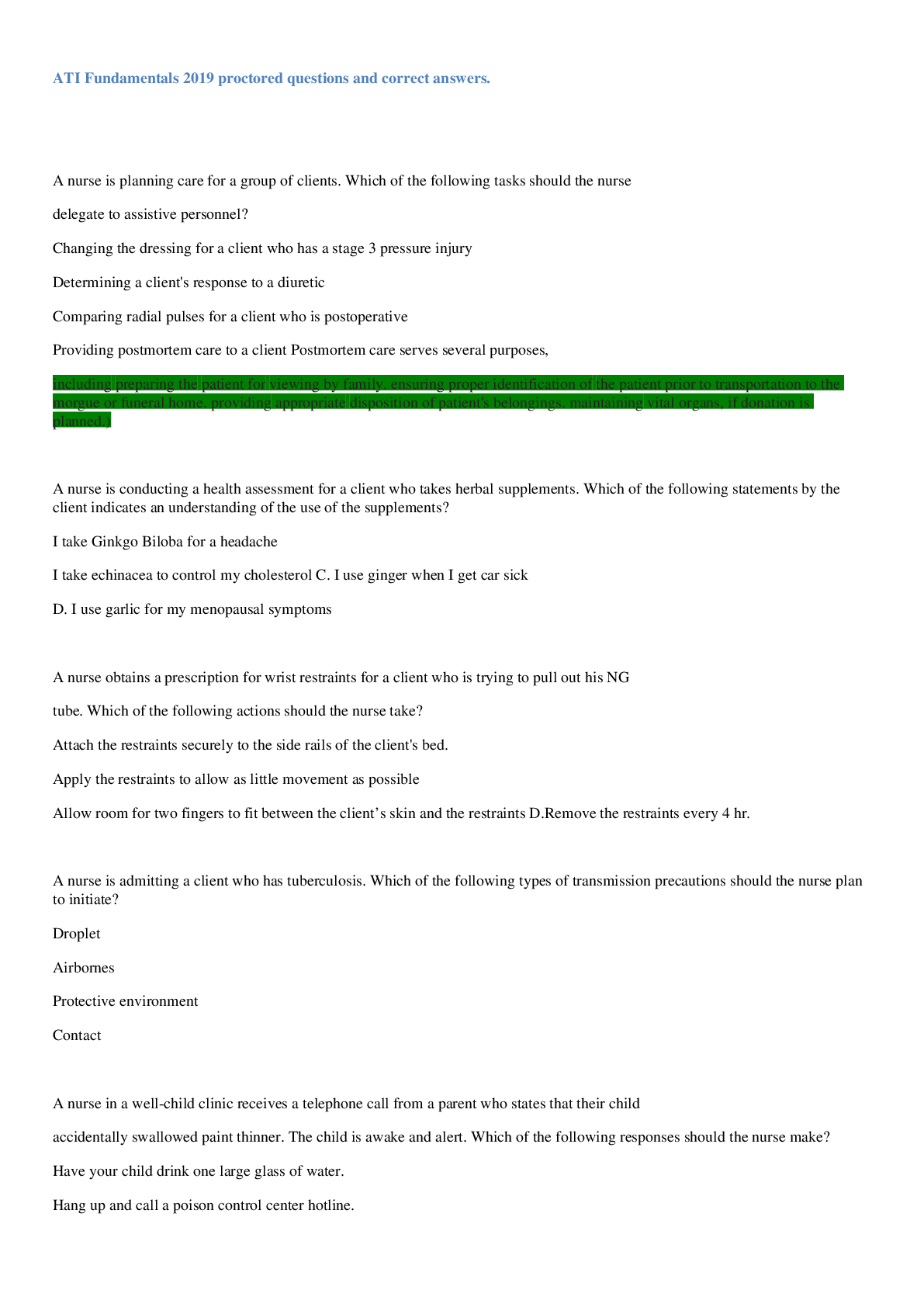
ATI Fundamentals 2019 proctored questions and correct answers.
ATI Fundamentals 2019 proctored questions and correct answers. 1. A nurse is planning care for a group of clients. Which of the following tasks should the nurse delegate to assistive personnel?...
By tutorcwakuthii , Uploaded: Aug 15, 2023
$12
*NURSING> EXAM > ATI Fundamentals Proctored Exam Questions and correct Answers 2023 updated (All)
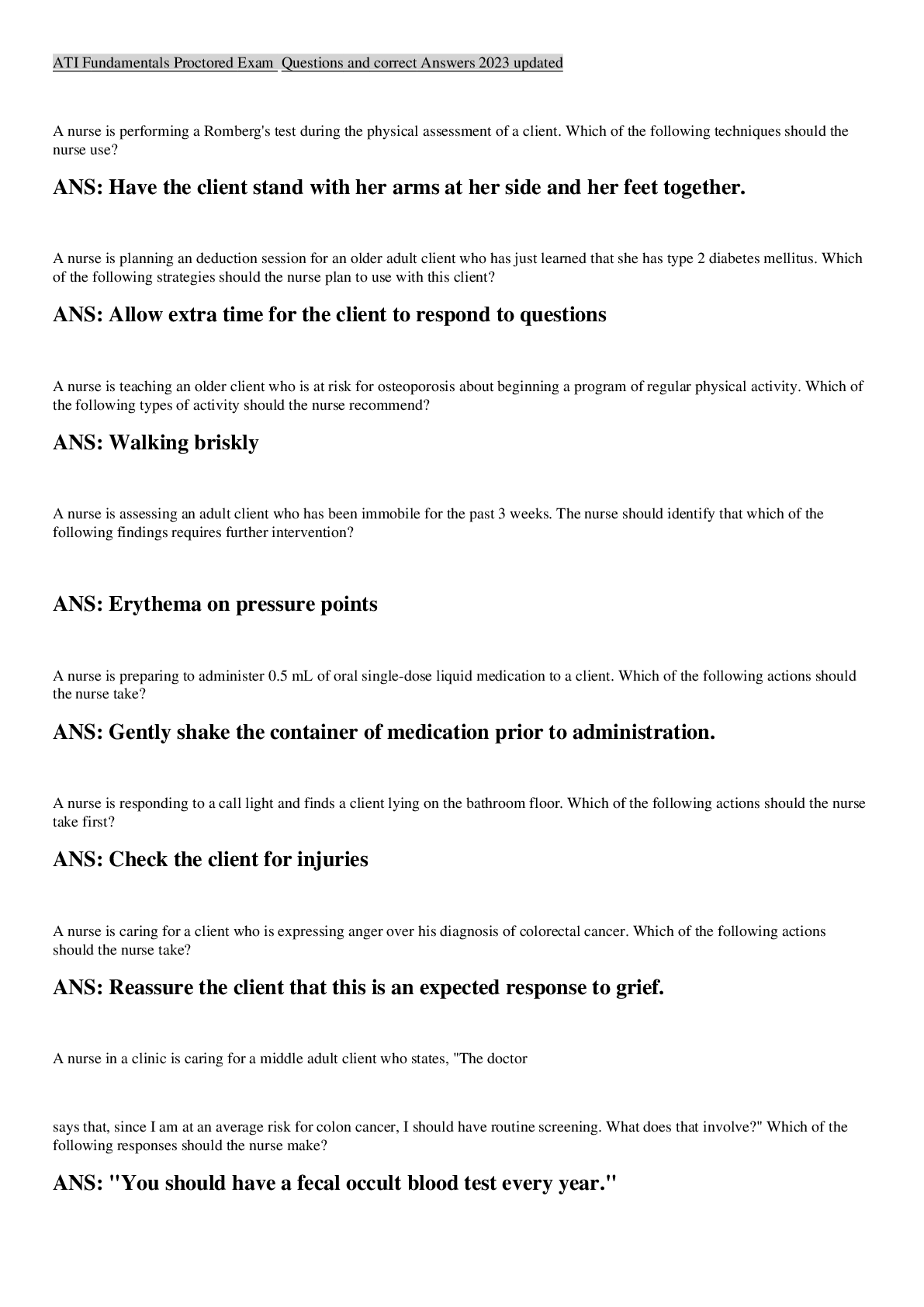
ATI Fundamentals Proctored Exam Questions and correct Answers 2023 updated
ATI Fundamentals Proctored Exam Questions and correct Answers 2023 updated 1) A nurse is performing a Romberg's test during the physical assessment of a client. Which of the following techniques...
By tutorcwakuthii , Uploaded: Nov 25, 2023
$10
NURSING.> EXAM > HESI LPN-ADN ENTRANCE EXAM (MOBILITY EXAMS) A+ GRADED 100% VERIFIED WITH QUESTIONS AND CORRECT ANSWERS 2023 (All)

HESI LPN-ADN ENTRANCE EXAM (MOBILITY EXAMS) A+ GRADED 100% VERIFIED WITH QUESTIONS AND CORRECT ANSWERS 2023
HESI LPN-ADN ENTRANCE EXAM (MOBILITY EXAMS) A+ GRADED 100% VERIFIED WITH QUESTIONS AND CORRECT ANSWERS 2023
By BESTGRADE01 , Uploaded: Jul 12, 2023
$12.5
*NURSING> EXAM > ATI RN COMPREHENSIVE 2023 PREDICTOR EXAM ACTUAL EXAM 180 QUESTIONS AND CORRECT ANSWERS/2023 ATI RN COMPREHENSIVE PREDICTOR EXAM QUESTIONS AND CORRECT ANSWERS|AGRADE (All)
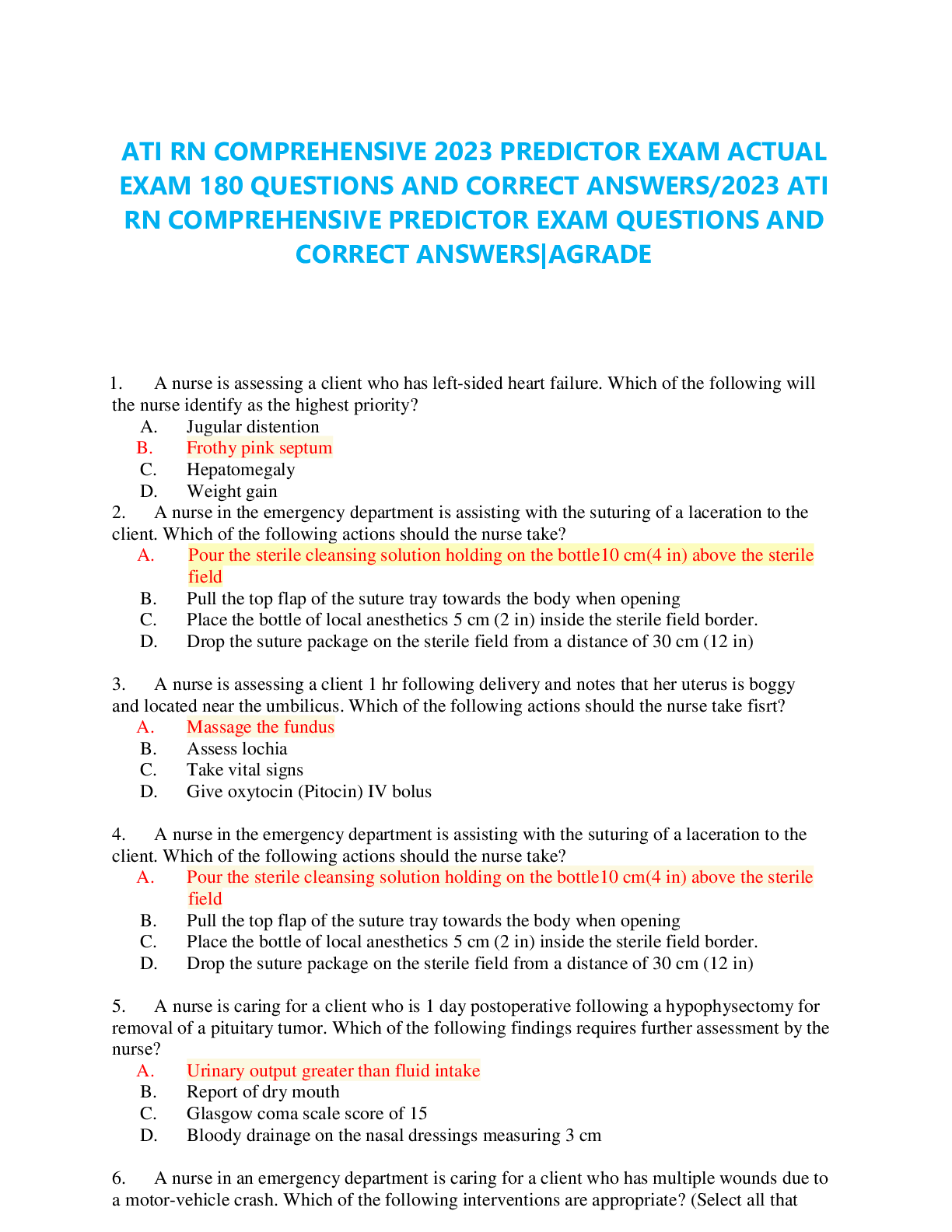
ATI RN COMPREHENSIVE 2023 PREDICTOR EXAM ACTUAL EXAM 180 QUESTIONS AND CORRECT ANSWERS/2023 ATI RN COMPREHENSIVE PREDICTOR EXAM QUESTIONS AND CORRECT ANSWERS|AGRADE
ATI RN COMPREHENSIVE 2023 PREDICTOR EXAM ACTUAL EXAM 180 QUESTIONS AND CORRECT ANSWERS/2023 ATI RN COMPREHENSIVE PREDICTOR EXAM QUESTIONS AND CORRECT ANSWERS|AGRADE
By Margaret020 , Uploaded: May 09, 2023
$150
Health Care> EXAM > OB HESI MATERNITY EXIT EXAM Questions with Answers practice Exam Guide: Download To Get An A (All)
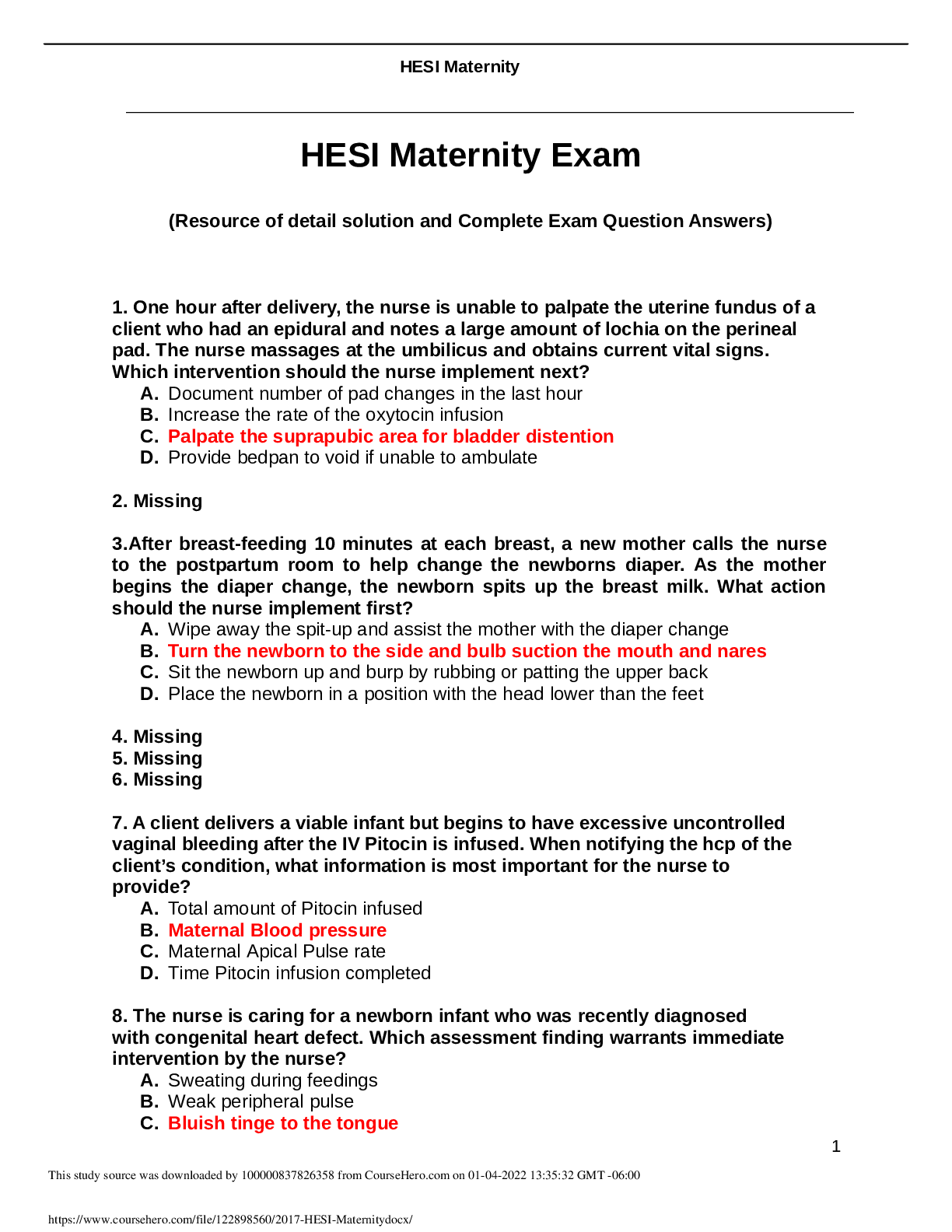
OB HESI MATERNITY EXIT EXAM Questions with Answers practice Exam Guide: Download To Get An A
OB HESI 1. One hour after delivery, the nurse is unable to palpate the uterine fundus of a client who had an epidural and notes a large amount of lochia on the perineal pad. The nurse massages at the...
By jakesuli , Uploaded: Jan 04, 2022
$13.5
Health Care> EXAM > NRNP 6566 FINAL EXAM LATEST 20232024/NRNP6566 FINAL ALL QUESTIONS AND CORRECT ANSWERS|AGRADE (WALDEN UNIVERSITY) (All)
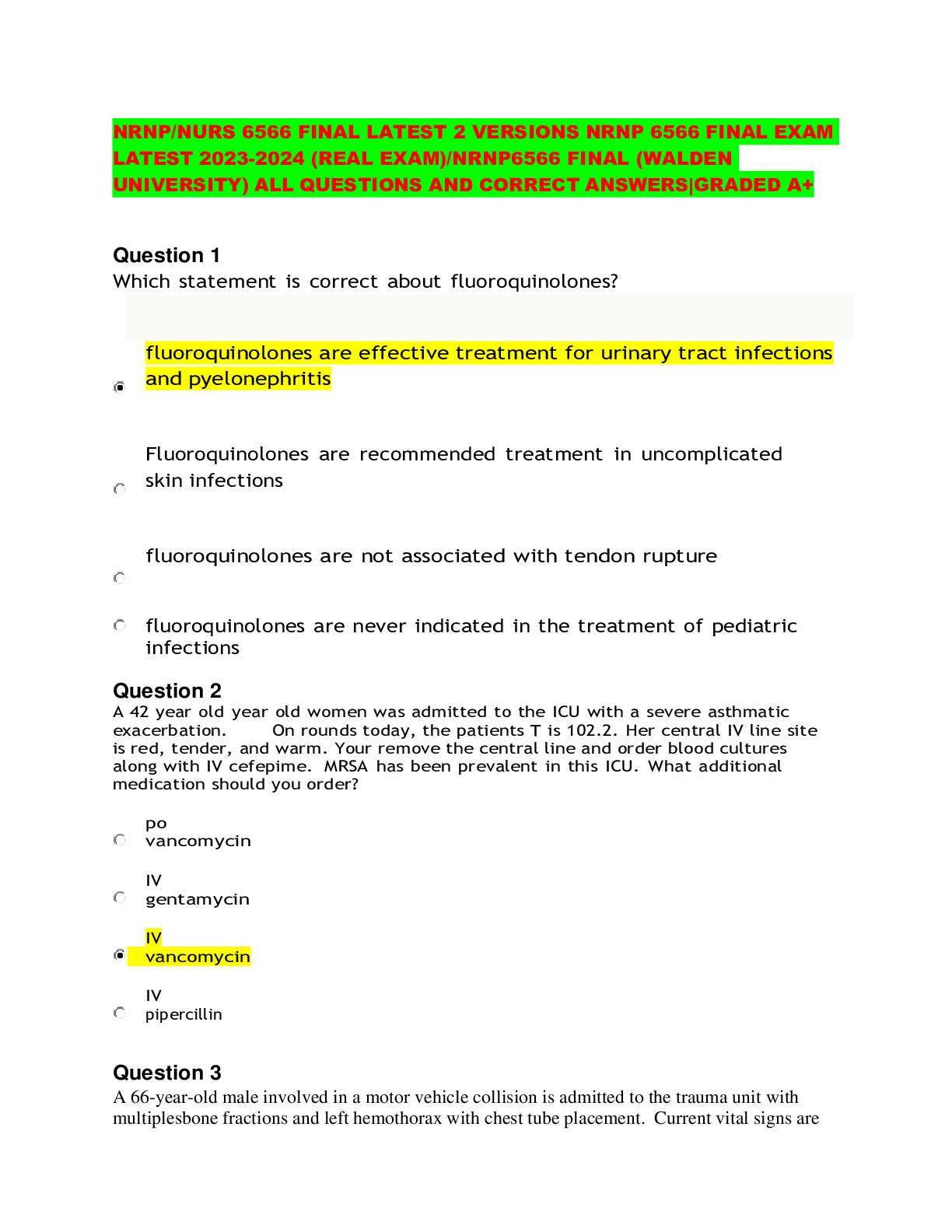
NRNP 6566 FINAL EXAM LATEST 20232024/NRNP6566 FINAL ALL QUESTIONS AND CORRECT ANSWERS|AGRADE (WALDEN UNIVERSITY)
NRNP 6566 FINAL EXAM LATEST 20232024/NRNP6566 FINAL ALL QUESTIONS AND CORRECT ANSWERS|AGRADE (WALDEN UNIVERSITY) Question 1 Which statement is correct about fluoroquinolones? fluor...
By johnkabiru , Uploaded: Jan 31, 2023
$25
Biology> EXAM > BIOL 3332 Exam 1: PRINTABLE VERSION. Reviewed and correct answers provided. (All)
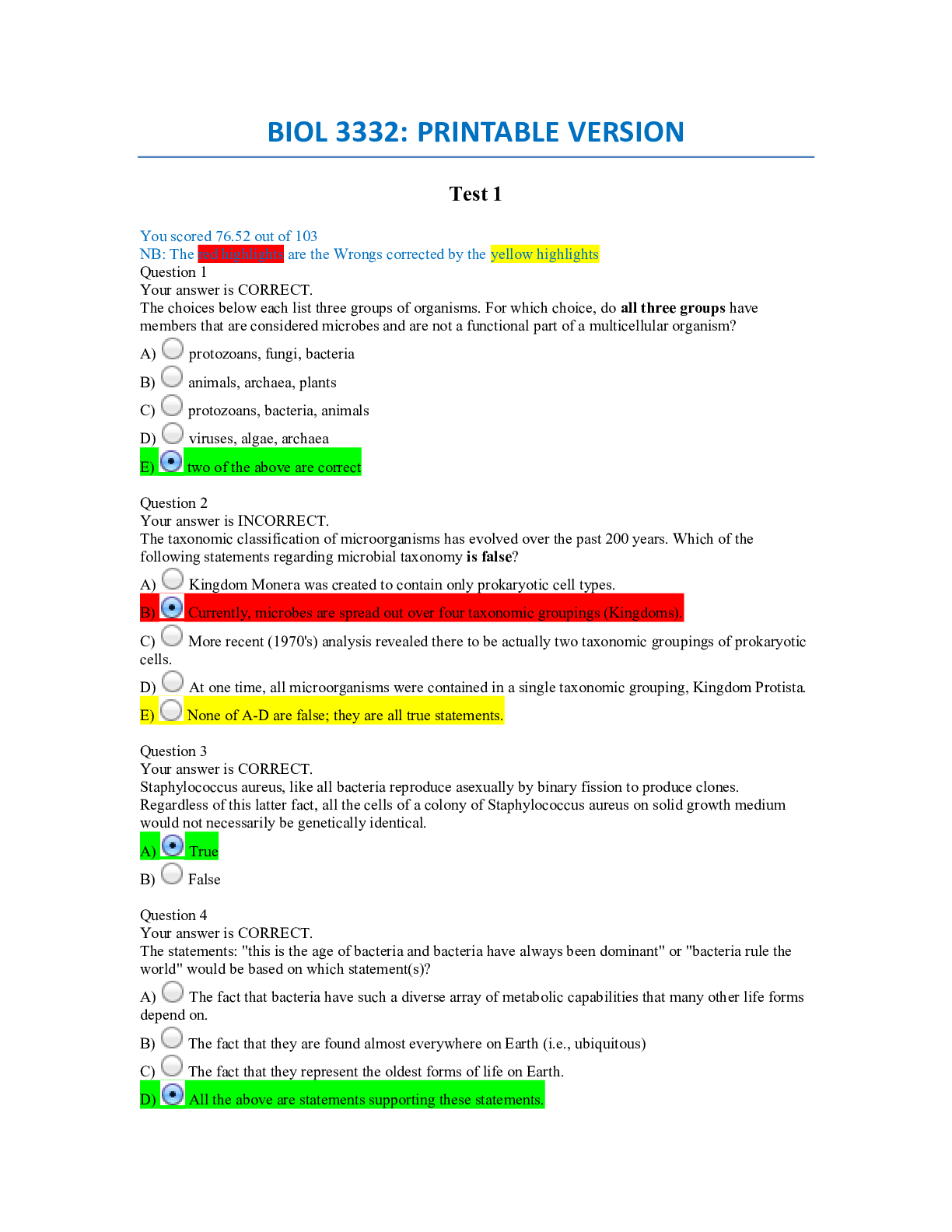
BIOL 3332 Exam 1: PRINTABLE VERSION. Reviewed and correct answers provided.
BIOL 3332: PRINTABLE VERSION Test 1 You scored 76.52 out of 103 NB: The red highlights are the Wrongs corrected by the yellow highlights Question 1 . The choices below each list three groups of...
By QuizMaster , Uploaded: Sep 22, 2020
$9.5
*NURSING> EXAM > HESI RN Psychiatric-Mental Health Exit Exam Questions And Answers (Latest 2020/2021 Version) (All)
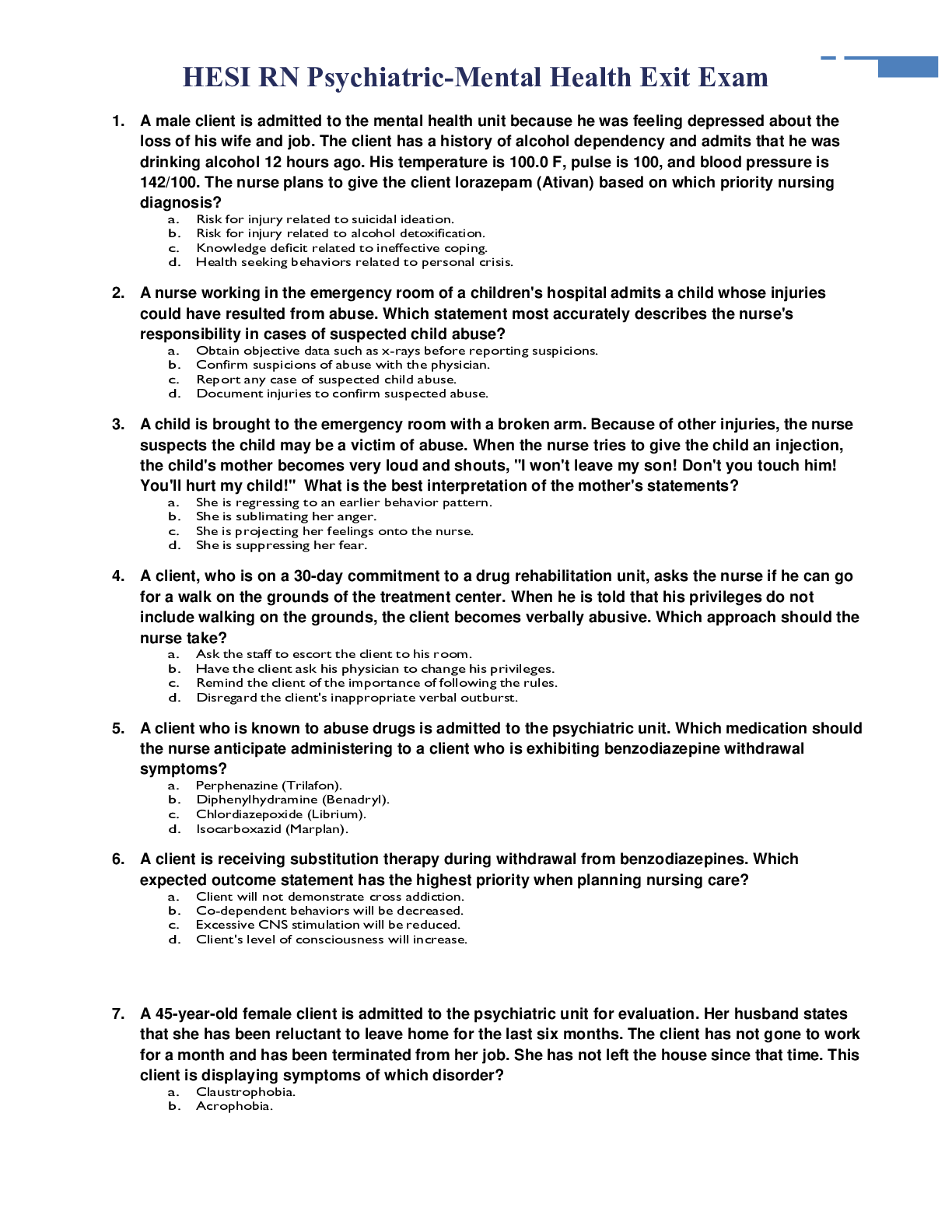
HESI RN Psychiatric-Mental Health Exit Exam Questions And Answers (Latest 2020/2021 Version)
HESI RN Psychiatric-Mental Health Exit Exam 1. A male client is admitted to the mental health unit because he was feeling depressed about the loss of his wife and job. The client has a history of alco...
By merit95 , Uploaded: Apr 26, 2021
$22
*NURSING> EXAM > 2020 Hesi PN Exit Exam Questions & Answers (All)
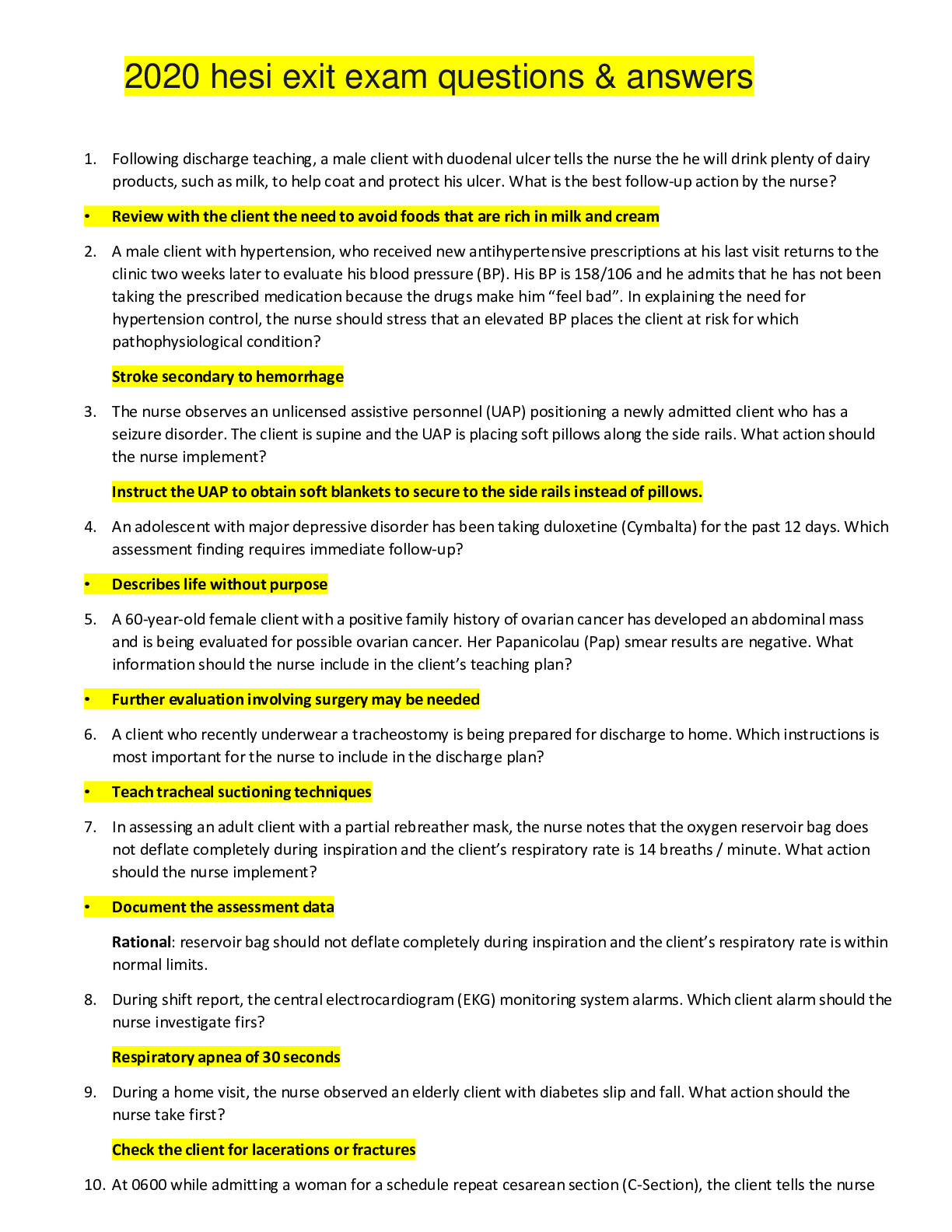
2020 Hesi PN Exit Exam Questions & Answers
2020 Hesi PN Exit Exam Questions & Answers/ 2020 Hesi PN Exit Exam Questions & Answers/ 2020 Hesi PN Exit Exam Questions & Answers
By Rixx Dennis , Uploaded: Mar 13, 2021
$15.5
Document information
Connected school, study & course
About the document
Uploaded On
Apr 02, 2021
Number of pages
21
Written in
Additional information
This document has been written for:
Uploaded
Apr 02, 2021
Downloads
0
Views
129






